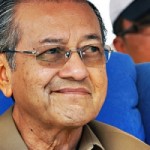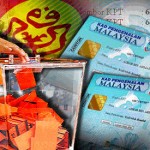my dear malaysia – what has become of you?
yesterday i CnP an article from the catholic asian news. – a view from a young man, and now read a view from a veteran. the writer here, k. george – name is familiar. i think he had written to malaysiakini a few times.
———————————————-
Catholic Asian News
August 2007
(Veteran unionist, writer and citizen K. George recalls the old days and asks…..)
My Dear Malaysia – What Has Become Of You?
Colonial Days
I CAME to this country as a soldier along with the 14th Army in September 1945. The 14th Army was a mighty force committed to expel the Japanese occupation from the countries in this region including Malaya. However, before the Army disembarked, the Japanese surrendered and the British colonialists returned to take control of Malaya.
The population consisted of Malays (later known as Bumiputra – the sons of the soil), Indians (mostly poor workers from south India) and Chinese (who came from China mostly to work in tin mines). There was also a group of aborigines who lived in seclusion in remote villages.
The colonisers having found vast areas of forest land, decided to resort to plantation industry. The Malays, although very poor and down-trodden were contented with their life in villages. They chose farming and fishing for a living.
The British sold tens of thousands of acres of land at one dollar (now known as ringgit) an acre to their counterparts. Their agents went to India and recruited thousands of workers mostly from south India. They were appointed by the white planters as indentured workers and treated as semi-slaves, strictly under the control of their bosses. Their wages, working and living conditions left much to be desired. The workers in tin mines were mostly Chinese. The community being rajin [hardworking] and natural risk-takers, were better off than the Indians and the Malays.
UMNO, MCA, MIC, CPM & IMP
There were some very interesting developments. With the end of the Second World War in 1945, there were persistent demands by several countries for independence. India (which included Pakistan), Sri Lanka, Burma and several others became independent by 1947.
In Malaya Datuk Onn bin Jaafar, a great son of Malaysia, succeeded in forming a political party called United Malays National Organisation (UMNO) which in fact, became the national party of the Malays. Sir Tan Cheng Lok took the initiative to register the Malayan Chinese Association, originally as an organisation to take care of the Chinese community which was subsequently registered as a political party. At that time, there was already a party for the Indian community known as the Malayan Indian Congress (MIC), initiated by John Thivy, a representative from India, originally aimed at joining the struggle for Indian independence.
Another interesting development was the arrival of two trade union leaders, sent by the Labour Party that took over the administration of the British government, having won the general election in England. Mention must be made with a sense of satisfaction that the two British Trade Union leaders were extremely helpful in organising our workers in trade unions without encountering any obstacles or problems, unlike the situation in Post-Merdeka.
At that time, the Communist Party of Malaya (CPM) headed by Chin Peng was already in existence. The party was actively involved in organising workers. In the early 1940s, when the Japanese occupied Malaya, Chin Peng and his supporters went underground along with the British, to expel the occupiers.
In appreciation of his service, the Communist leader was awarded OBE (Order of the British Empire) by the British government and was invited to the Victory Parade in the United Kingdom. He turned the award and invitation down.
There was yet another unforgettable development in our country. Datuk Onn after discussing with the leaders of UMNO, MCA and MIC came to the conclusion that for the progress and prosperity of Malaya, it was desirable to have a multi-racial political party. It was agreeable to all of them. He then called for an inaugural meeting which was held in Kuala Lumpur in 1951. I was personally present and registered my name in support of the Independence of Malaya Party (IMP).
All those present gave their full support except one person, Tunku Abdul Rahman who was the Vice President of UMNO. Tunku however, agreed on the dual membership for UMNO members but again he changed his mind and announced that any UMNO member who joined IMP would be expelled from UMNO. It still puzzles me as to why the Tunku deviated from his undertaking. A few months later there was local council elections. Shockingly UMNO and MCA formed an alliance to contest the local council election. It was the death-knell to IMP. It was indeed an unforgettable set-back to the nation.
The British government indicated that they were prepared to give independence to Malaya on condition that all the three communities must join together to receive it. So, the MIC sneaked into the Alliance.
Granting of Merdeka
Having taken into consideration the political changes that have been taking place in many countries, the communist parties of various countries held a conference in February 1948 in Calcutta and resolved that the parties in non-independent countries would demand independence from the colonialists.
The CPM submitted its demand for independence for Malaya but the British government was not prepared. For the Tunku was not happy. Consequently, CPM went underground and started guerilla warfare. The Malaysian government declared a state of emergency. Finally independence was granted to the Alliance and thus Malaya became independent on 31stAugust 1957.
Post Merdeka
There was a general election in 1959. The Alliance headed by the Tunku won the election and formed the government, dominated by UMNO.
There was a union called the Factory and General Workers Union, headed by Dr. V. David, a prominent and committed leader. The UMNO led government disliked “General Unions”. The government enacted the Internal Security Act 1960 and then arrested David under the ISA and subsequently abolished general unions. So when David was released after a couple of months, his union had ceased to exist. David was already a Member of Parliament along with a number of opposition leaders.
David joined the Transport Workers Unions. He started to spread his wings and was an able and popular union leader nationally and internationally.
Mahathir, Labour & Gerakan
In the 1960s, Dr. Mahathir Mohamad became a member of UMNO. He published a book – “The Malay Dilemma” – criticising the Alliance government for not taking care of the Malays. The book was banned and Mahathir was expelled from UMNO.
The Labour Party which formed the Socialist Front, participated in the first post Merdeka election and won a number of seats in the Parliament and state assemblies. The government clamped down and deregistered the Labour Party for reasons best known to themselves.
A number of leaders including Dr. Tan Chee Khoon, V. David and many others decided to form another party known as Party Gerakan Rakyat Malaysia. I was invited to participate. I, in return, accepted the invitation. Gerakan was a multi-racial party and was well-received by all the races. The Gerakan not only won a number of seats but also captured the State of Penang in the 1969 General Election which remains so even till today. In 1963, Sabah and Sarawak joined Malaya. As a result Malaya became Malaysia.
At the May 1969 General Elections, UMNO did not fare as well as in the past elections. Suddenly on May 13 there were racial riots. It is a tragedy that remains vivid in my memory. The government declared National Operation Council, headed by Abdul Razak. Tunku Abdul Rahman was appointed Secretary General of the Organisation of Islamic Conference (OIC). Razak invited Mahathir to rejoin UMNO. In 1974, Mahathir became the Minister of Education. Razak died in 1976 and Tun Hussein Onn became the third PM and Mahathir became the DPM.
In 1981, Hussein resigned and Mahathir took over as the fourth PM.
New/National Economic Policy
In 1970, the Alliance became a Coalition of 14 parties. Having found that the economic equity of the Malays and the Bumiputras needed improvement, the Razak government decide to introduce the New Economic Policy (NEP) aimed at attaining 30% equity within 20 years beginning 1970. However, after 23 years, NEP was re-named National Economic Policy.
A survey made by the government found that the equity has only reached 19%. Hardly anybody, especially economic analysts could believe it.
Asli, an independent non-government organisation, disclosed that according to its analysis the equity has reached 45%. However, they underlined that the poor and downtrodden Malays still remain poor. Prime Minister, Abdullah vehemently rejected the Asli report.
The Director of Asli maintained that his analysis is absolutely correct because Asli has to ensure that its integrity is upheld.
Now Abdullah says the NEP will continue (indefinitely).
The Indians
The Indians equity was estimated at 1% in 1970 and has now come down to 0.8%! A survey of the suicide rates in our country made about 6 months ago revealed that the rate amongst the Indians was the highest along with the number of crimes committed by them.
This has taken place alongside repeated appeals for the economic policy of a country to be aimed at a just and equitable distribution of wealth, irrespective of race and religion.
The Mahathir Era
Datuk Seri [now Tun] Dr. Mahathir Mohamad became the fourth Prime Minister in July 1981, following the resignation of Tun Hussein Onn on medical grounds. He called upon the people to be “Bersih, Cekap dan Amanah” [Clean, Efficient and Trustworthy]. “Look East” was his economic policy to emulate the Japanese work ethic. Before embarking on privatisation, Dr. Mahathir, fondly known as Dr. M, assured the nation open tender and transparency.
In the 1987 General Assembly of UMNO, Mahathir almost lost the Presidentship of UMNO to Tengku Razaleigh Hamzah. When Anwar Ibrahim, who treated Mahathir as his ‘father’ came to know of it, he volunteered to give up his UMNO Youth leadership, if anyone could reverse the situation. Najib Razak, who had promised the 43 votes in four of the UMNO divisions in Pahang to Razaleigh, who had been his mentor, changed his decision. When the election result was announced the next day, Mahathir won the contest by 43 votes.
Later on Najib became the Youth leader without a contest and the Deputy Prime Minister – a private agreement Abdullah unwillingly reached with Mahathir so as to enable him to become the PM.
Mahathir decided once and for all that nobody was going to challenge him. He managed to get a court decision to nullify UMNO, the dominant ruling party. Then within days, UMNO Baru was registered. One of the clauses stated that to be a candidate of UMNO Presidentship, one must be nominated by 30% of the divisions. UMNO Baru was closed to the Tunku, Tun Hussein Onn, Razaleigh and several other Malay leaders.
In 1988, Mahathir, managed to get the Lord President Tun Salleh Abbas and two senior judges dismissed, which frightened judiciary.
He went on spending the nation’s wealth on prestigious mega-projects. Cronyism, nepotism, favouritism and bail out were rampant in the 80s and 90s. Corruption became endemic. In 1987, 106 citizens were detained under the ISA in one go. Later on many others followed. All this instilled fear in the people.
Mahathir resigned on 30th October 2003. Enter Datuk Seri Abdullah Ahmad Badawi as the fifth PM. We, the people thought that a great man has taken over the leadership of the nation as we gave him a massive mandate.
We were “feeling good”.
But not many are “feeling good” today.













Leave a Reply
You must be logged in to post a comment.